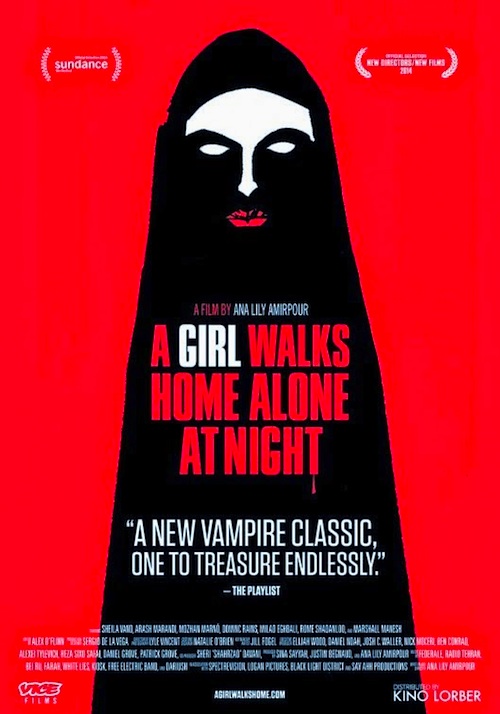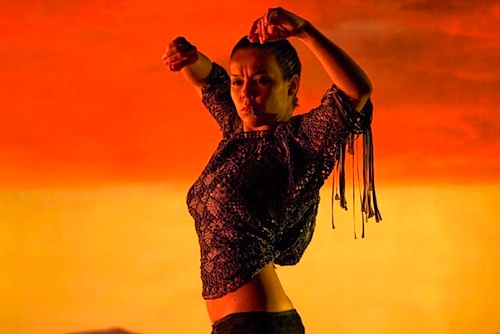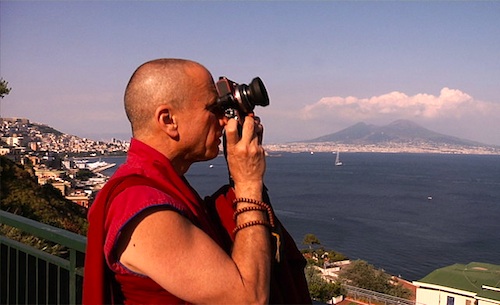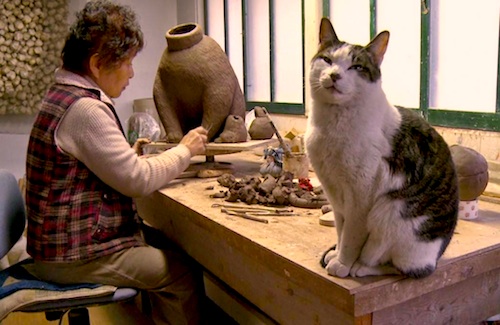By Joe Bendel. This vampire wears a chador rather than a cape. She is clearly not an Anne Rice kind of vampire, but you will still find plenty of vice in Bad City, where she stalks her victims. Ana Lily Amirpour finally delivers the Iranian existential rock & roll vampire western the world has been waiting for with A Girl Walks Home Alone at Night, which opens this Friday in New York.
The dialogue is Persian, but it was shot in a California boom-and-bust oil town that easily passes for a lawless provincial corner of Iran. Although not explicitly political, there is no way the regime would ever cotton to a depiction of Iranian society rife with prostitutes, pimps, pushers, and junkies (frankly, they are just no fun whatsoever). Of course, this seedy environment makes a perfect hunting ground for “the Girl,” who prowls through Bad City’s dark streets late at night on her skate board.
Like an old school E.C. Comics blood-sucker, the Girl generally bites those who have it coming, such as “the Pimp,” who has been hassling “the Persian James Dean” over his junkie father’s debts. Or at least he had been. Yet, the Girl somehow develops a friendship with “the Prostitute” despite their very different temperaments. However, it is her halting mutual attraction to the Persian James Dean that really challenges her choice of undead lifestyle.
 AGWHAAN sounds absolutely crazy on paper and indeed in many ways it is, but it is an art film through-and-through rather than a cult midnight movie. Amirpour’s pacing is slow and deliberate, in a seductive kind of way. If audiences are not careful, Bad City will anesthetize them. Fortunately, the driving alt rock-rockabilly soundtrack supplies plenty of aural caffeine (this is a case where a soundtrack album could easily out-perform the source film).
AGWHAAN sounds absolutely crazy on paper and indeed in many ways it is, but it is an art film through-and-through rather than a cult midnight movie. Amirpour’s pacing is slow and deliberate, in a seductive kind of way. If audiences are not careful, Bad City will anesthetize them. Fortunately, the driving alt rock-rockabilly soundtrack supplies plenty of aural caffeine (this is a case where a soundtrack album could easily out-perform the source film).
Regardless, viewers should stick with AGWHAAN, because it is a truly unique cinematic experience, starting with Lyle Vincent’s gobsmackingly arresting black-and-white cinematography. Arguably, the film is stylistically most closely akin to the work of Bruce Weber (best known for directing Calvin Klein commercials and the Chet Baker doc Let’s Get Lost).
AGWHAAN is the sort of film that washes over you, yet it still heralds the arrival of a major star in Sheila Vand. As the Girl, she gives a quiet but deeply expressive performance. Somehow she is able to look exquisitely vulnerable and eerily sinister at the same time, which is quite a trick. Likewise, Mozhan Marnò defies all clichés with her sensitive work as the prostitute.
There is something wonderfully subversive about a delicate looking lady vampire wreaking havoc on Iran’s low life men. Who wouldn’t love to see her take the bite to the oppressive theocrats in a sequel? A rich feast for eyes and ears, it is completely unlike any other vampire movie you have previously seen. Highly recommended for fans of ambitious genre film and Persian cinema, A Girl Walks Home Alone at Night opens this Friday (11/21) in New York at the IFC Center.
LFM GRADE: A
Posted on November 17th, 2014 at 7:49pm.


